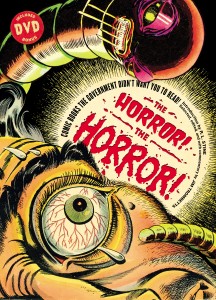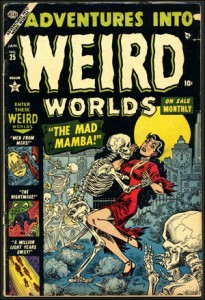 “THIS BOOK CONTAINS: MURDER! MAYHEM! ROBBERY! RAPE! CANNIBALISM! CARNAGE! NECROPHILIA! SEX! SADISM! MASOCHISM … and virtually every other form of crime, degeneracy, bestiality, and horror!”
“THIS BOOK CONTAINS: MURDER! MAYHEM! ROBBERY! RAPE! CANNIBALISM! CARNAGE! NECROPHILIA! SEX! SADISM! MASOCHISM … and virtually every other form of crime, degeneracy, bestiality, and horror!”
The words above appear in a report from the mid-1950s titled “Comic Books and Juvenile Delinquency” from the Committee on the Judiciary’s investigation of juvenile delinquency in the United States. It serves as a reminder that more recent concerns about certain forms of music, violence in film, and other forms of popular culture, are part of a long and ongoing series of debates about entertainment and youth. In this instance those in positions of cultural leadership in 1950s America were concerned about horror comics, a story that is detailed in the fine book The Horror! The Horror! Comics Books the Government Didn’t Want You to Read! (Abrams ComicArts, 2010) by Jim Trombetta.
For some reason 1950s horror comics have received a lot of attention lately in various horror magazines and books, and The Horror! The Horror! is an important part of this mix. But while much of the focus is often on the important contribution of EC Comics, this volume moves beyond that to remind the reader of a broad section of horror comics that fascinated and frightened young people during the post-war period. This book reproduces cover art, and at times the inner content, of long-forgotten horror comics such as Marvel Tales, Spellbound, Spook, Strange Terrors, Horrific, Strange Fantasy, and a host of others. Although modern generations of young people are used to plenty of on screen blood and gore in their horror in film and television, there is still plenty in these comics that contemporary readers may find appropriately revolting and worthy of horrific respect.
The Horror! The Horror! not only features color reproductions of 1950s horror comics, but also helpful introductory material where Trombetta sets the cultural stage for the rise of these pop-culture artifacts. Produced as a way of dealing with the national trauma’s of the Great Depression and World War II, Trombetta writes:
“These comics conveyed the unspeakable, and maybe even unthinkable, trauma of a whole society, but in a streetwise, urban-legend way. On one hand, they could be more reactionary, racist, and brutal than the surrounding culture, as if to rub the reader’s nose in a deliberate caricature. On the other hand, their radicalism could be startling. They kicked ove the biggest triumph in history just to see what might crawl out.”
From this cultural matrix Trombetta not only traces the rise of horror comics from crime comics, and discusses the government’s reaction to horror comics among youth, but also includes discussion of various common horror elements found in these materials, such as the werewolf, magic, skeletons, decapitated heads, and various forms of the undead.
 One of the main features of this book is not only a fresh consideration of 1950s horror comics, but also the furor they caused as government officials feared they had the potential to corrupt youth. As Trombetta describes on the inside cover of the book, ‘[t]hese outrageous comic book images, [were] censored by Congress in an infamous televised U.S. Senate subcommittee hearing in 1954 investigating juvenile delinquency”. Although this may seem outrageous to us in the 21st century, we might recall that in 2007 Congress held hearings on gangsta rap lyrics, a repeat of similar hearings in the 1990s spearheaded by Tipper Gore. Another interesting feature of this book is its inclusion of a DVD with a documentary television show Confidential File that makes the case for the dangers of horror comics on youth through drama and interviews. As one individual in the documentary pleads with viewers:
One of the main features of this book is not only a fresh consideration of 1950s horror comics, but also the furor they caused as government officials feared they had the potential to corrupt youth. As Trombetta describes on the inside cover of the book, ‘[t]hese outrageous comic book images, [were] censored by Congress in an infamous televised U.S. Senate subcommittee hearing in 1954 investigating juvenile delinquency”. Although this may seem outrageous to us in the 21st century, we might recall that in 2007 Congress held hearings on gangsta rap lyrics, a repeat of similar hearings in the 1990s spearheaded by Tipper Gore. Another interesting feature of this book is its inclusion of a DVD with a documentary television show Confidential File that makes the case for the dangers of horror comics on youth through drama and interviews. As one individual in the documentary pleads with viewers:
“The final responsibility for the control of crime and horror comics rests with you. A few cities have already done something about them, not too many, but a few. Legislation against unfit comic books is possible. Legislation that won’t interfere with the rights of a free press. Contact your city officials. Let them know how you feel about the crime and horror comics. And remember this: America is the richest country in the world. We’re the world’s biggest producer of goods. But our most important commodity, the one commodity we can’t put a price tag on, is our children.”
The Horror! The Horror! is a fine addition to any collection on comic books, art, and horror in general. It can be purchased through the TheoFantastique Store.





There are no responses yet